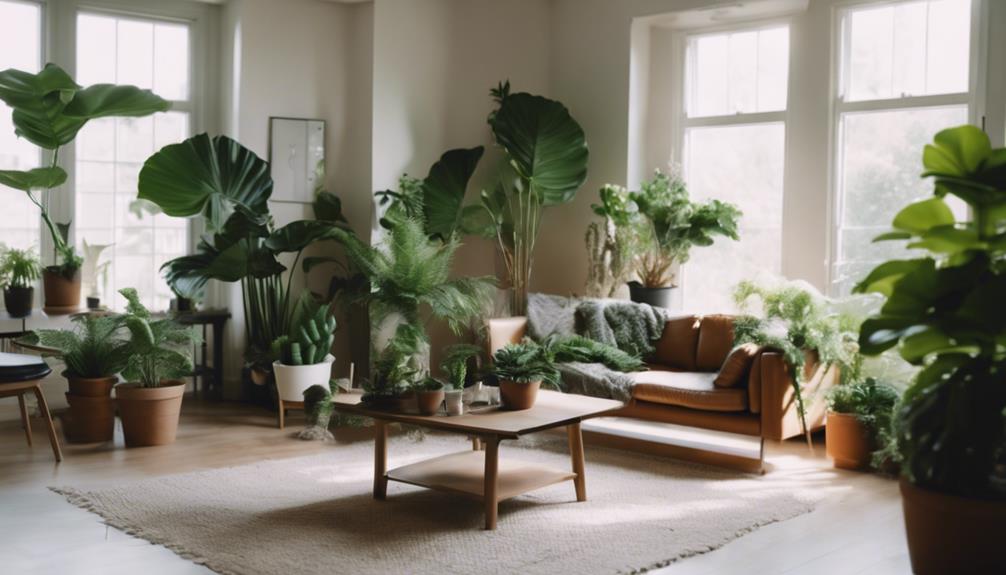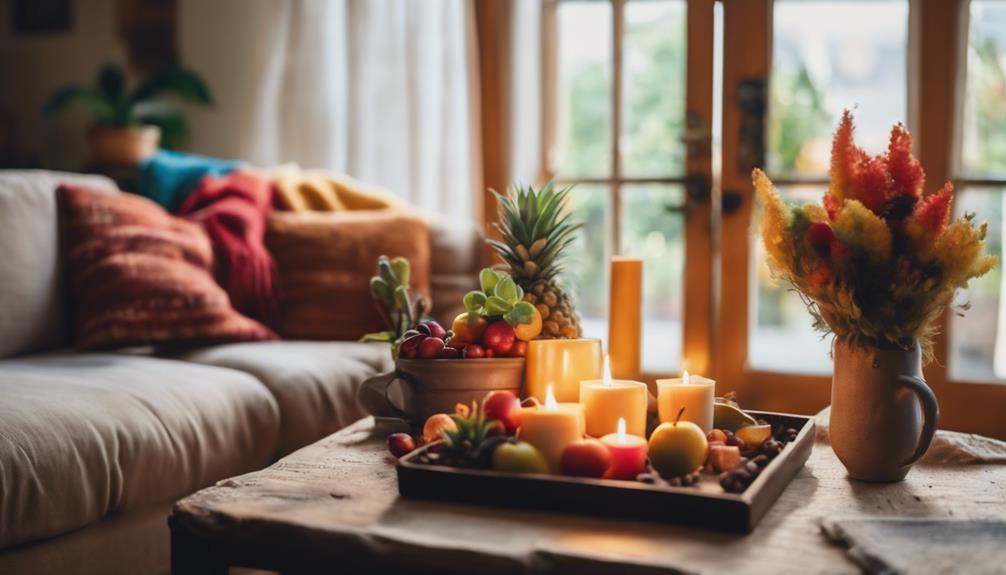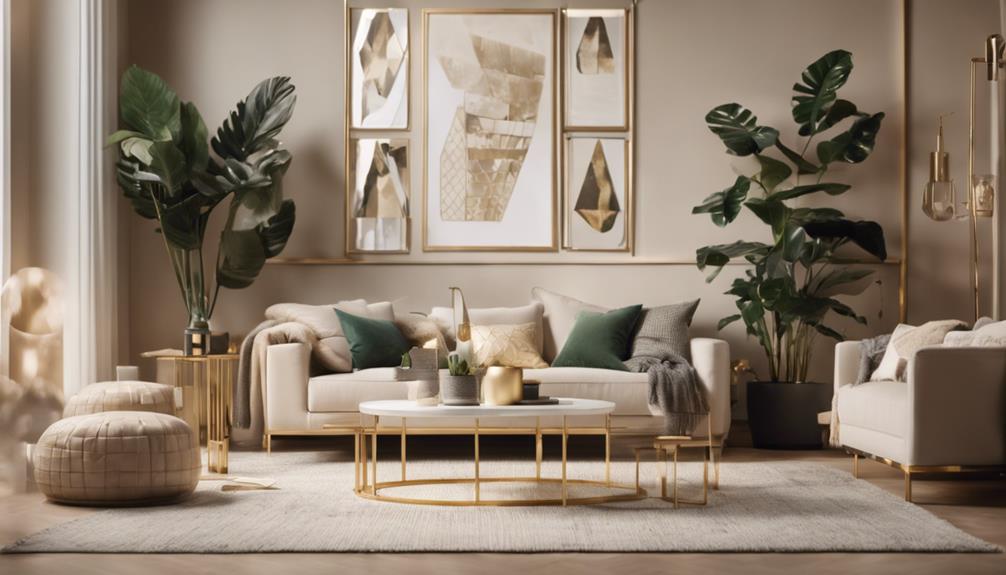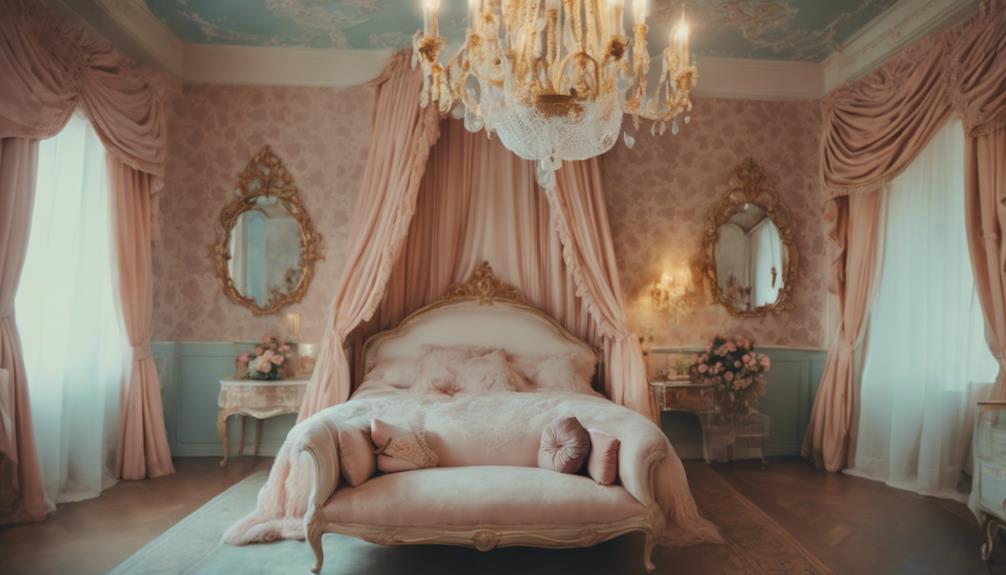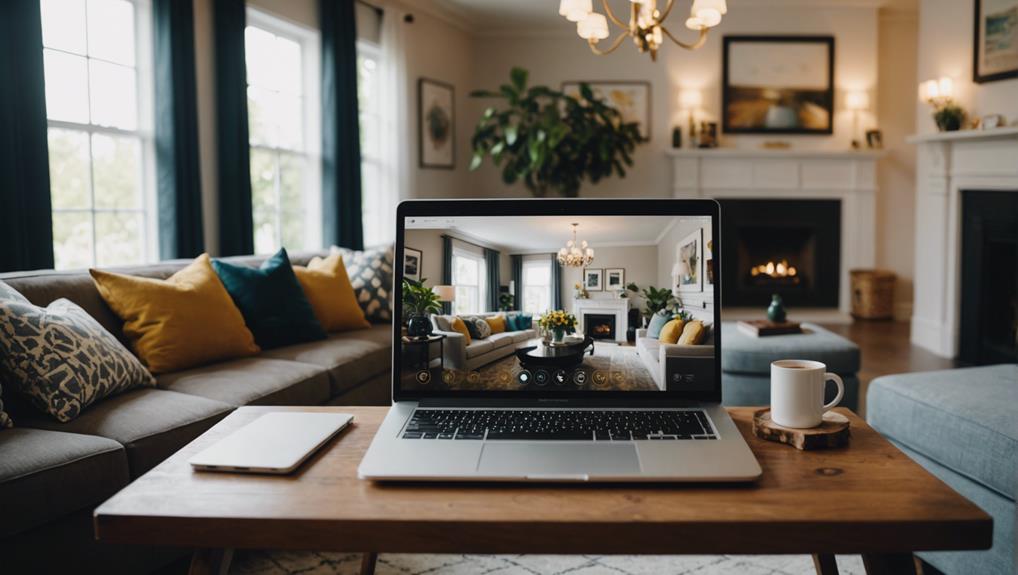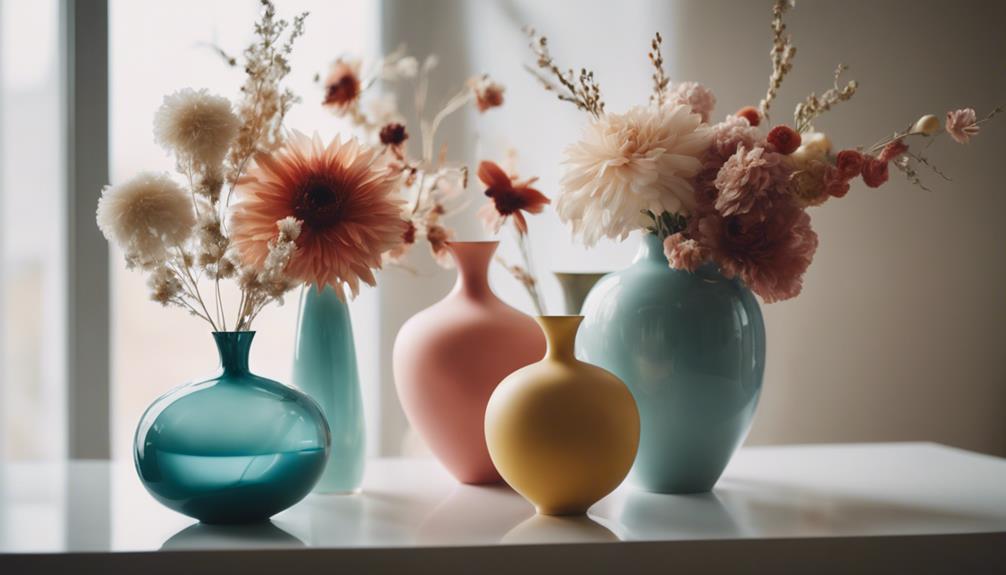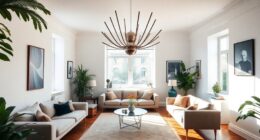To create a fresh Scandinavian ambiance, you should choose plants that complement the minimalist aesthetic. Consider options like snake plants or pothos, which thrive indoors and add vibrant greenery. Rubber plants and peace lilies also fit well, offering a touch of color with their rich leaves. Group your plants in ceramic pots with neutral tones to enhance the decor. You'll want to pick low-maintenance varieties that align with the cozy essence of Scandinavian design. These choices will elevate the natural feel of your space, and there's even more to explore about combining plants with other design elements.
Key Elements
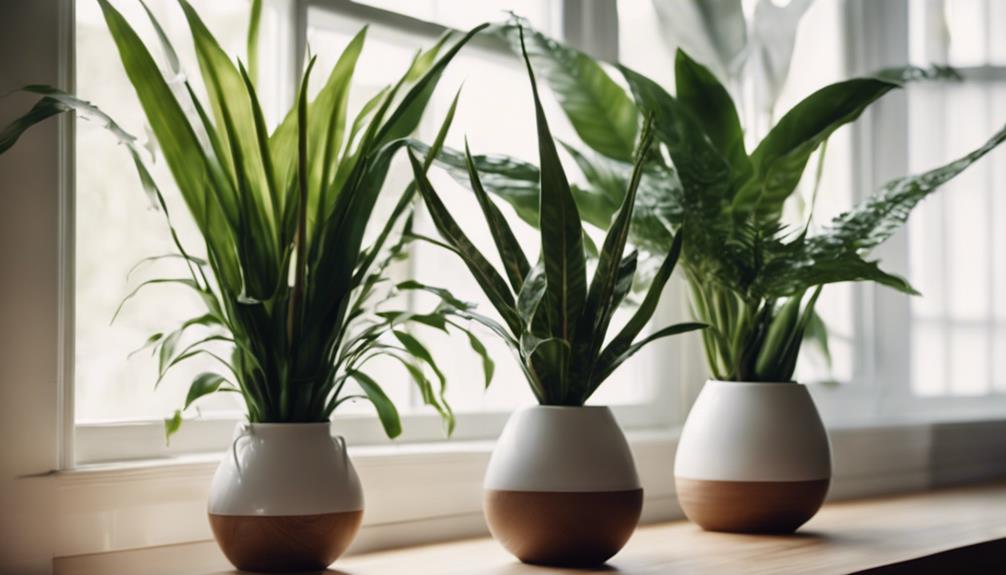
When creating a Scandinavian ambiance, focus on a cohesive color scheme that highlights neutral tones and vibrant greens.
You'll also want to contemplate materials and textures that add warmth and depth to your space.
Color Scheme
A Scandinavian color scheme embraces a neutral palette of whites, grays, and beiges, setting a calm foundation for your indoor plants. This serene backdrop allows your greenery to shine without overwhelming the space.
Incorporating pastel colors or earth tones can add warmth and subtle contrast, enriching the overall aesthetic while maintaining the minimalist vibe.
When choosing houseplants, consider vibrant options like Monstera deliciosa or Ficus elastica. These plants introduce invigorating green hues that pop against your neutral walls and furniture, enhancing the tranquil atmosphere.
To complete the look, select plant pots in soft, muted tones that harmonize with the color scheme, ensuring your plants blend seamlessly into the environment.
Additionally, using natural materials like wood and rattan in your decor complements the Scandinavian style and reinforces the cozy ambiance. Opting for furniture and accents made from these materials will create a cohesive feel, allowing your indoor greenery to thrive as an essential part of your home.
Materials
Incorporating natural materials like wood, wicker, and rattan not only enhances the cozy vibe of Scandinavian interiors but also creates a harmonious backdrop for your plants.
You'll find that solid oak furniture is a staple, providing warmth and a sturdy base that complements the beauty of greenery. The use of neutral tones in Scandinavian design allows your plants to truly stand out, making the space feel inviting and fresh.
Rattan baskets are particularly popular for housing houseplants, adding texture and a splash of warmth to your decor without overpowering it. They're perfect for showcasing low-maintenance plants that thrive in various conditions, ensuring that even if you're not a gardening expert, you'll still have a thriving green space.
Avoiding plants to kill is essential, so stick to varieties that require minimal care, letting you enjoy the beauty of nature without the stress.
Textures
Textures play an essential role in creating the warm and inviting atmosphere characteristic of Scandinavian design. By incorporating natural materials like wood, rattan, and jute, you can enhance the cozy vibe in your space. Adding soft textiles, such as wool and linen, provides layers of comfort while keeping the minimalist aesthetic central to Scandinavian style.
When you introduce indoor plants, you not only bring in vibrant greenery but also add organic textures that create a striking contrast against sleek furniture. The interplay of these elements fosters visual interest, making your home feel more dynamic. Opt for matte finishes on plant pots and furniture surfaces to maintain the understated elegance that defines Scandi interiors.
Combining various textures is key. For instance, smooth ceramics can pair beautifully with rough natural fibers, creating a harmonious balance that reflects simplicity and functionality. As you curate your space, focus on how these textures work together, ensuring that each element contributes to a cohesive Scandinavian ambiance.
Ultimately, the right mix of textures will transform your home into a serene retreat that embodies the essence of Scandinavian living.
Essential Fixtures and Furniture
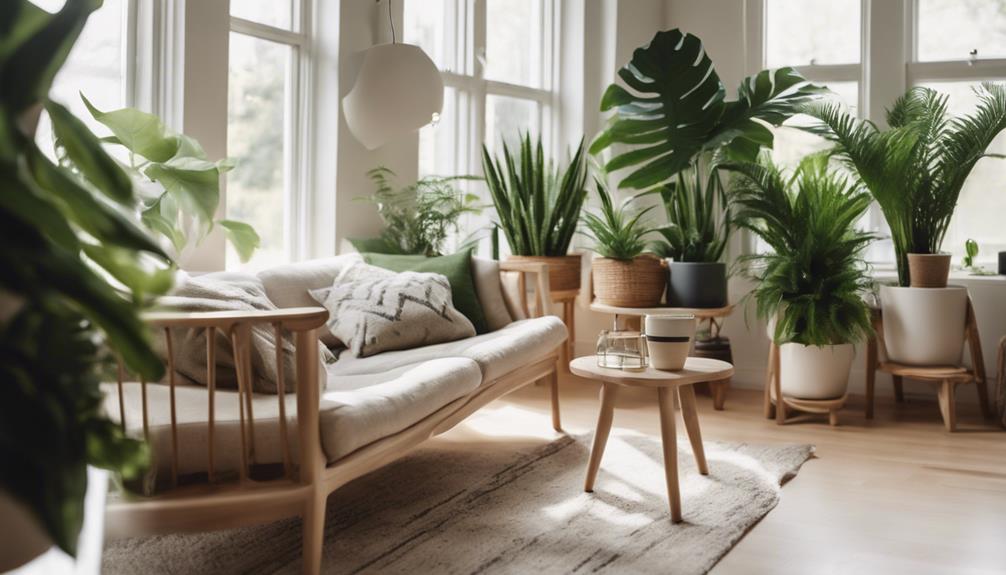
To create the perfect Scandinavian ambiance, you'll want to focus on essential fixtures and furniture that enhance your space.
A natural wood dining table and a Scandinavian-style coffee table can anchor your room, while a hanging pendant light fixture adds a touch of warmth and modernity.
Together, these elements work harmoniously with your plants, elevating the overall aesthetic.
Natural Wood Dining Table
A natural wood dining table serves as the heart of Scandinavian interiors, showcasing warmth and simplicity while seamlessly blending with various plant arrangements. Solid oak is a popular choice, offering durability and a timeless aesthetic that enhances your interior ambiance. The light finishes often used in Scandinavian design help accentuate the natural grain of the wood, making the table a standout piece in your home.
These dining tables are versatile, fitting into styles ranging from rustic to contemporary, which allows you to create a cohesive look with your chosen plants. Whether you're hosting a casual dinner or a formal gathering, a natural wood dining table adapts beautifully to your needs, adding an inviting touch to your space.
Custom designs are also available, ensuring that your dining table meets specific spatial requirements while harmonizing with the overall Scandinavian aesthetic. By incorporating this essential fixture, you're not just furnishing your home; you're cultivating an ambiance that reflects the organic beauty and functionality characteristic of Scandinavian interiors.
Scandinavian-Style Coffee Table
Building on the warm appeal of a natural wood dining table, a Scandinavian-style coffee table further enhances your living space with its clean lines and minimalist design.
These tables typically feature simple lines and natural materials like oak or birch, which maintain a sense of openness in your neutral-colored apartment.
Not only do they showcase a low-profile aesthetic, but many designs also offer multifunctionality. You'll find coffee tables with shelves or drawers, helping you keep your space tidy and organized. This practicality aligns perfectly with the Scandinavian principle of simplicity and tranquility.
To elevate your coffee table's look, consider incorporating Scandinavian decor plants. Plants are a great way to add greenery and warmth to your living area, complementing the clean lines and overall design.
Pairing your table with soft textiles or decorative plant arrangements can create that cozy atmosphere characteristic of Scandinavian decor.
Whether you're hosting friends or enjoying a quiet evening, a Scandinavian-style coffee table serves as a functional centerpiece that reflects your taste for minimalism and nature.
Embrace this style to bring both beauty and practicality into your home.
Hanging Pendant Light Fixture
Hanging pendant light fixtures play an essential role in Scandinavian interiors, blending functional lighting with a minimalist aesthetic that enhances your space. These fixtures not only illuminate but also contribute greatly to the cozy atmosphere that defines Scandinavian design. You'll often find them crafted from natural materials like metal, glass, and wood, reflecting the simple beauty of nature.
When selecting a hanging pendant light, consider the height and positioning. Hanging them lower over dining tables or kitchen counters fosters an intimate feel, perfect for gatherings or quiet dinners. Their minimalist designs can complement the clean lines of your Scandinavian furniture, creating a cohesive look that elevates the overall ambiance of the room.
Soft, warm light is a common feature of these fixtures, aligning perfectly with the Scandinavian emphasis on comfort and simplicity. Whether you opt for a single statement piece or a cluster of lights, your choice will greatly impact the room's character.
Lighting Ideas
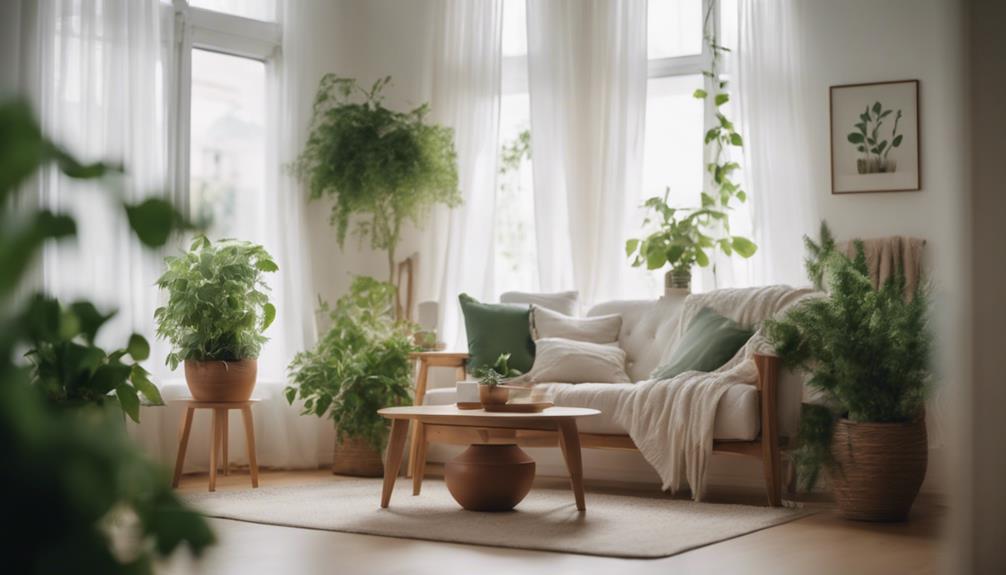
To enhance your Scandinavian ambiance, consider incorporating warm LED pendant lights for a cozy glow.
Sculptural table lamps and geometric floor lamps can add a modern touch while maintaining the minimalist aesthetic.
Don't forget about natural fiber pendant lights, which bring a touch of nature indoors and complement your plant decor beautifully.
Warm LED Pendant Lights
Warm LED pendant lights instantly elevate your space, creating a cozy and inviting atmosphere that perfectly complements the minimalist Scandinavian aesthetic.
These fixtures typically emit a warm glow around 2700K, mimicking the soft light of traditional bulbs while being energy-efficient. You'll find that hanging these stylish decor elements above dining tables or kitchen islands not only provides focused illumination but also enhances the overall design of your home.
Opt for pendant lights with simple, clean lines made from materials like metal, wood, or glass to maintain a cohesive look. This aligns beautifully with the Scandinavian design principles that prioritize functionality and aesthetics.
One of the standout features of warm LED pendant lights is their versatility; they can seamlessly fit into any space, whether it's a cozy nook or an expansive dining area.
Incorporating dimmable options adds to the adjustable ambiance, allowing you to tailor the lighting to suit different moods or occasions. This adaptability not only promotes relaxation and comfort but also encourages you to enjoy your space in a whole new light.
Embrace warm LED pendant lights, and watch your home transform into a serene sanctuary.
Sculptural Table Lamp Design
Sculptural table lamps seamlessly blend form and function, adding an artistic touch to your Scandinavian-inspired space. These lamps emphasize minimalist aesthetics with clean lines and organic shapes, making them perfect for a Scandi-style space. Often crafted from materials like wood, metal, and glass, they incorporate natural elements that enhance your connection to nature, which is a hallmark of Nordic interiors.
When selecting a sculptural lamp, look for designs that feature geometric forms or asymmetrical shapes. These styles not only provide functional lighting but also contribute a modern flair that complements the simplicity of Scandinavian design. Opt for lamps in neutral tones or soft colors, as they harmonize beautifully with the typical Scandinavian color palette, which often includes whites, greys, and earthy hues.
Additionally, many sculptural table lamps utilize efficient LED lighting, aligning with the eco-friendly values central to Scandinavian principles. By choosing the right lamp, you can create an inviting atmosphere that pairs well with your favorite plants, enhancing the overall freshness and tranquility of your space while adhering to those minimalist aesthetics you cherish.
Geometric Floor Lamp Design
Geometric floor lamps enhance your Scandinavian-inspired space with their clean lines and minimalist design, creating a striking yet harmonious atmosphere. These lamps embody the Scandinavian ethos of simplicity and functionality, making them ideal for any room. Their angular shapes and distinctive geometric forms serve as statement pieces without overwhelming your decor.
Typically crafted from natural materials like wood or metal, these lamps seamlessly integrate into the organic aesthetic of Scandinavian interiors. Their use of neutral colors, such as whites and greys, maintains a calm and cohesive ambiance, perfect for minimalist spaces. This subtle color palette not only complements your existing decor but also enhances the overall tranquility of your home.
Many geometric floor lamps come with adjustable features, allowing you to customize light intensity and direction according to your needs. This practicality enhances comfort, making your living space both stylish and functional.
Natural Fiber Pendant Light
Natural fiber pendant lights effortlessly elevate your Scandinavian space by introducing warmth and texture while maintaining a minimalist aesthetic. Crafted from materials like rattan, jute, or bamboo, these fixtures enhance the organic feel of Scandinavian interiors without overwhelming the design. Their simple, clean lines align perfectly with the principles of functionality and simplicity, making them ideal for any room.
When you pair a natural fiber pendant light with houseplants, you create a cozy ambiance that beautifully highlights the greenery in your home. This combination invites nature indoors, fostering a serene and inviting atmosphere. Available in various shapes and sizes, these lights can serve as statement pieces or subtle accents, offering versatility in your decorating style, whether modern or traditional.
Additionally, the use of sustainable materials in natural fiber pendant lights reflects a commitment to eco-friendly design, resonating with the growing demand for environmentally conscious home decor. By choosing these fixtures, you not only enhance your space but also contribute to a more sustainable lifestyle.
Embrace the charm of natural fiber pendant lights to complete your Scandinavian-inspired haven.
Decorative Elements
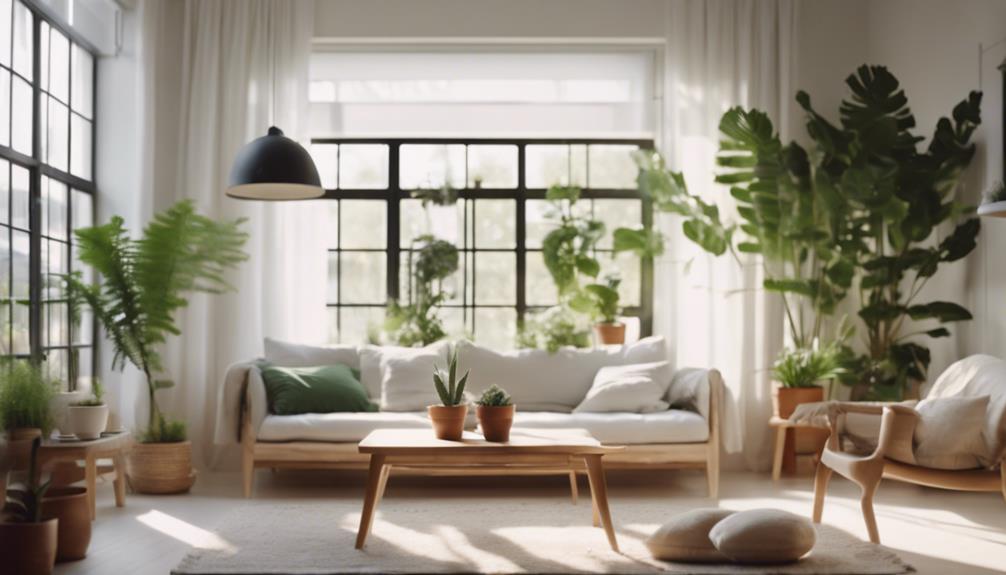
To create a truly Scandinavian ambiance, you should focus on your decorative elements.
Arranging ceramic plant pots can add a sleek touch, while incorporating textured wall art pieces and handwoven wall hangings brings warmth and character to your space.
These choices not only highlight your greenery but also enhance the overall aesthetic.
Ceramic Plant Pot Arrangement
Creating a visually appealing ceramic plant pot arrangement elevates your Scandinavian decor by adding clean lines and a touch of minimalist elegance. Ceramic plant pots are perfect for Scandinavian interiors, thanks to their sleek designs and neutral colors like white, grey, and beige. These hues enhance the light, airy feel typical of this style, creating a serene atmosphere.
When you arrange your ceramic pots, consider grouping various sizes to create visual interest and depth. This dynamic arrangement not only draws the eye but also embodies the Scandinavian principle of natural beauty. Don't shy away from experimenting with different finishes, such as matte or glossy, which can introduce subtle textures that complement organic materials found in your decor.
Moreover, ceramic pots help retain moisture, providing a stable environment for your plants, essential for keeping them healthy indoors. By thoughtfully arranging your ceramic plant pots, you'll achieve a harmonious balance that reflects the simplicity and functionality of Scandinavian design.
Embrace the beauty of your plants while enhancing your space with these elegant elements.
Textured Wall Art Piece
Textured wall art pieces add depth and intrigue to Scandinavian interiors, enhancing the minimalist aesthetic while staying true to the style's clean lines. By incorporating textured wall art, you can easily transform a simple space into a warm and inviting atmosphere. Look for pieces made from natural elements like wood, rattan, or woven textiles that resonate with the Scandinavian design ethos.
Choosing artwork in neutral tones and earthy colors will complement the typical palette of whites and pastels found in Scandinavian interiors. Consider art featuring organic shapes or geometric patterns to harmonize with the clean aesthetic that defines this style. These elements not only contribute visual interest but also align with the functionality that Scandinavian design embodies.
When selecting textured wall art, think about how it interacts with your plants and other decor. The right piece can elevate your entire design scheme, creating a cohesive look that feels both modern and timeless. Overall, textured wall art is a fantastic way to enrich your space, reflecting the beauty of simplicity while showcasing your personal style in Scandinavian interiors.
Handwoven Wall Hanging
Handwoven wall hangings bring a unique touch of warmth and personality to Scandinavian interiors, perfectly blending with the overall minimalist aesthetic. These decorative elements introduce rich textures that soften the clean lines typical of Scandi design. Crafted from natural materials like wool, cotton, and jute, they resonate with the region's commitment to sustainability and eco-friendly practices.
When you choose a handwoven wall hanging, you create a focal point that complements the neutral tones found in many Scandinavian spaces. Many of these artworks feature geometric patterns or nature-inspired motifs, enhancing the connection to the natural world that Scandinavian design embodies.
Moreover, incorporating a handwoven piece harmonizes beautifully with indoor plants, helping to establish a cozy ambiance in your home. The combination of organic textures from both the wall hanging and the plants elevates the overall aesthetic, making your space feel inviting and warm.
Flooring
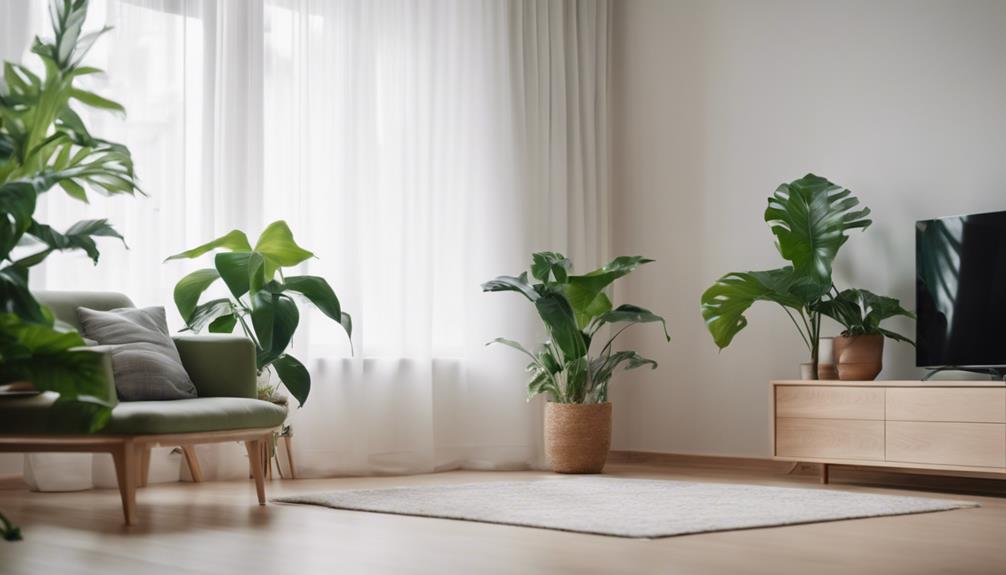
When creating a Scandinavian ambiance, your flooring choices play a vital role.
You'll often find light-colored hardwoods like oak or whitewashed pine floorboards that enhance the airy feel of the space.
Reclaimed wood floorboards also add a touch of warmth and sustainability, perfectly aligning with the Scandinavian ethos.
Light-Colored Hardwood Flooring
Light-colored hardwood flooring is essential for achieving the airy and bright atmosphere typical of Scandinavian design. By reflecting natural light, it enhances your space, making it feel more open and inviting. Popular options like oak, ash, and birch not only offer durability but also bring warm tones that complement your decor.
This flooring style creates a seamless connection between your indoor and outdoor spaces, embodying the Nordic principle of bringing nature inside. When you choose light-colored hardwood, you align perfectly with the minimalist aesthetic that defines this design style. It allows your neutral palettes to shine, while also making vibrant plants pop against the backdrop.
Maintaining light-colored hardwood flooring is straightforward; regular cleaning and occasional refinishing will keep it looking its best. This minimal upkeep means you can focus on showcasing your beautiful plants and decor without the worry of extensive maintenance.
In your Scandinavian-themed home, light-colored hardwood flooring serves as an ideal foundation, enhancing the overall ambiance and ensuring your space feels harmonious and serene. Embrace this choice, and watch how it transforms your living area into a bright, welcoming retreat.
Whitewashed Pine Floorboards
Whitewashed pine floorboards create an inviting and airy atmosphere, perfect for achieving that quintessential Scandinavian design aesthetic. These floorboards are a staple in Scandinavian interiors, offering a light color that enhances the natural grain of the wood while contributing to a neutral palette. This softness harmonizes beautifully with both light and dark furnishings, allowing your decor flexibility.
One of the primary benefits of whitewashed pine is its ability to reflect natural light, making your space appear larger and brighter—particularly essential during the darker winter months. This light and airy feel pairs wonderfully with various types of greenery, inviting nature indoors and creating a revitalizing ambiance.
Moreover, whitewashed pine aligns with the values of environmental consciousness that are central to Scandinavian culture. Typically treated with eco-friendly finishes, these floorboards guarantee both durability and sustainability.
Reclaimed Wood Floorboards
Reclaimed wood floorboards offer a sustainable and stylish flooring option that enhances the warmth and character of Scandinavian interiors. By choosing reclaimed wood, you're opting for eco-friendly flooring made from salvaged materials that reduce waste and promote sustainability. The unique textures and colors of reclaimed wood add a distinct character to your space, perfectly complementing the minimalist aesthetic typical of Scandinavian design.
Using natural materials like reclaimed wood not only elevates the visual appeal of your home but also improves indoor air quality, as it's free from harmful chemicals often found in new flooring options. Additionally, reclaimed wood is renowned for its longevity; the wood comes from trees that have matured over decades, making it a durable choice for any household.
Installing reclaimed wood flooring can also greatly enhance your property's value, as it's considered a desirable feature in contemporary home design. Pair your beautiful reclaimed wood floors with indoor plants to create a fresh, inviting atmosphere that embodies the essence of Scandinavian living.
With reclaimed wood, you're not just flooring your home; you're adding a story, warmth, and sustainability to your living space.
Conclusion
To achieve that fresh Scandinavian ambiance, don't forget to incorporate the right plants.
They not only add life but also harmonize with your minimalist decor. Choose low-maintenance options like succulents or ferns for easy care.
Pair them with essential fixtures and soft lighting to enhance the cozy atmosphere.
With the right elements in place, your space will feel inviting and serene, embodying that perfect blend of simplicity and nature.
Embrace the beauty of Scandinavian design!
